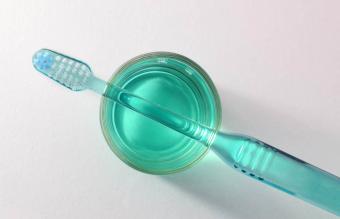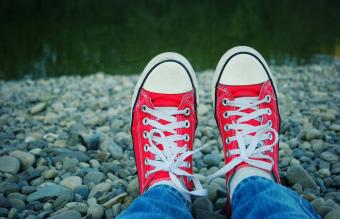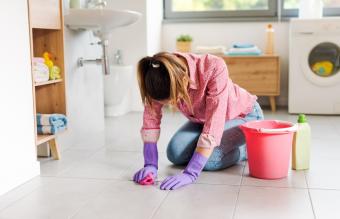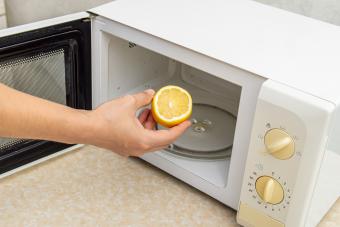
You need to know how to disinfect a toothbrush in order to kill the germs that can live on its surfaces. Whether you've been sick, you're trying to avoid getting sick, or you've dropped your brush some place undesirable and you're worried it's now contaminated with bacteria and other harmful micro-organisms, each of these sanitization methods can make it clean again.
10 Ways to Disinfect a Toothbrush and Kill Germs
There are several methods you can use to disinfect your toothbrush. Just remember to only use a particular cleaning solution once and then dispose of it immediately.
How to Disinfect a Toothbrush With Hydrogen Peroxide

Hydrogen peroxide is an easy-to-find disinfectant that's available at pharmacies and most grocery stores.
- Prior to brushing your teeth, combine one cup of water and one teaspoon of 3% hydrogen peroxide in a glass.
- Swish the brush around in the solution to saturate it and let it sit in water for a few minutes.
- Give the brush a good rinse and then brush your teeth.
Using Denture Cleaning Tablets to Clean Your Toothbrush
The quick foaming action of denture cleaner tablets makes this product another option for toothbrush cleaning.
- Add about three inches of warm water to a glass, and drop in the denture-cleaning tablet.
- Immerse the head of the toothbrush in the foaming water and swish it around for a second or two to make sure it's saturated.
- Let the brush soak in the solution for the amount of time specified on the package, typically three to five minutes.
- Swish the toothbrush around for a few more seconds to make sure all debris has been removed from the bristles.
- Wash the handle with soap and water.
- Rinse the entire brush thoroughly under clean running water, tap the excess water out of the bristles, and let them air dry in a safe place.
How to Use Mouthwash as a Toothbrush Disinfectant

Antibacterial mouthwash can also be used to disinfect your brush.
- Pour enough mouthwash into a small glass to cover the bristle end of the brush completely.
- Swish the brush around for approximately 30 seconds to remove any hidden debris and then let it soak for a few minutes.
- Do not leave the brush in the mouthwash for more than 15 minutes or it could damage the bristles.
- Wash the handle with soap and water.
- Rinse the entire brush and allow it to air dry before the next use.
Disinfect Your Toothbrush With Baking Soda
You've probably heard of using baking soda to brush your teeth, but you can also use it to sanitize your toothbrush.
- Dissolve 2 teaspoons of baking soda in one cup of warm water.
- Rinse your toothbrush under running water to remove any obvious debris from the bristles.
- Soak your toothbrush in the solution for about one hour.
- Rinse the brush thoroughly with clean water and let it air dry.
How to Disinfect a Toothbrush With Vinegar
Vinegar is a wonderful natural cleaner, so put it to work disinfecting your toothbrush too.
- Add enough white vinegar to a small glass to cover the bristle end of your brush.
- Let the brush soak overnight to kill the germs.
- Rinse the brush well before the next use.
Boiling a Toothbrush to Kill Germs
Boiling water can kill the germs in your toothbrush and doesn't require any additional ingredients to do it.
- Bring a small pan of water to a boil (212 F/100 C)
- Place the toothbrush in the pan for about three minutes, then remove it with tongs.
- Lay the brush on a fresh paper towel until it's cool enough to handle.
- Tap the excess water from the bristles and then put the brush away to air dry.
Clean a Toothbrush in Your Dishwasher
It might not seem an obvious choice, but you can sanitize your toothbrush in a dishwasher.
- Put the brush in the silverware tray.
- Run it through a regular cycle.
According to a study published on PubMed, the dishwasher method was one of the two most effective methods for killing Streptococcus germs, while sanitizing a brush in the microwave was the second most effective treatment.
Microwave Method to Disinfect a Toothbrush
As mentioned, microwaving proved useful for killing Strep germs on a toothbrush according to one study.
- Set the bristle end of the brush in a glass of water.
- Microwave for 5 minutes.
- Carefully remove the brush from the water, and place it in a safe place to air dry.
It should be noted that even though microwaving can kill germs, the process could potentially damage your brush, so only try this method if you already have another toothbrush you can use to replace it if needed.
Using a Toothbrush Sanitizer

The CDC doesn't recommend using a sanitizer unit to kill the germs on your toothbrush because they say it can damage the bristles. However, these units are available as UV sanitizers and steam sanitizers and are said to kill approximately 99% of germs on brushes. If you choose to try one of these units, follow the product directions and make sure you have an extra toothbrush on hand if your usual one is damaged.
Can Rubbing Alcohol Disinfect a Toothbrush?
According to Arctic Dental, yes, you can sanitize a toothbrush in rubbing alcohol.
- Rinse the brush first to remove any trapped particles.
- Soak the brush in isopropyl/rubbing alcohol for about 30 seconds and then rinse well before use.
Note, vodka can substitute for rubbing alcohol in a pinch and should also be rinsed away before brushing.
How to Clean an Electric Toothbrush
You can follow the same techniques when it comes to cleaning the head of an electric toothbrush as you do for a standard toothbrush. Just be sure to disconnect the toothbrush head from the electric base before you clean. When your toothbrush head doesn't detach be sure to only clean the head and bristles.
Tips for Keeping Toothbrush Germ-Free When Traveling
Depending on how you store your toothbrush when traveling, it can be hard to keep it clean and disinfected. One of the best ways is to keep a germ-free is to cover it with a travel case on the head of the toothbrush. You can also try a few of these tips to disinfect your toothbrush while traveling.
- Fill a cup with an antiseptic mouthwash and allow the brush to soak for 5 or so minutes.
- Put vodka in a cup and allow the toothbrush to sit for a few minutes.
- Heat a cup of water in the microwave until boiling. Put the toothbrush in the water and let it sit until it's cooled.
- Put your toothbrush in a plastic bag to avoid germs from getting on it from the air.
Health Tips for Keeping Toothbrushes Clean and Germ-Free

Work these practices into your routine in order to keep your brushes as clean as possible. This works to help prevent bacteria build-up on your toothbrushes as well.
- Wash your hands before and after you brush your teeth.
- Always rinse your brush to remove food particles trapped in the bristles.
- Replace your brush every three to four months.
- Store brushes at least three feet away from the toilet.
- Always store family toothbrushes so they don't touch each other and never share someone else's brush.
- Store toothbrush in hydrogen peroxide that is changed daily.
- Consider using a toothpaste dispenser to reduce cross-contamination.
- Sanitize toothbrush holders and covers every two weeks to avoid bacteria build-up.
A Clean Toothbrush Is Worth the Effort
Whether it's cold and flu season or just an average day, keeping your toothbrush clean helps protect your overall health. All the sanitization methods mentioned here require minimal effort on your part, so it's easy to do what you need to do to stay healthy.







